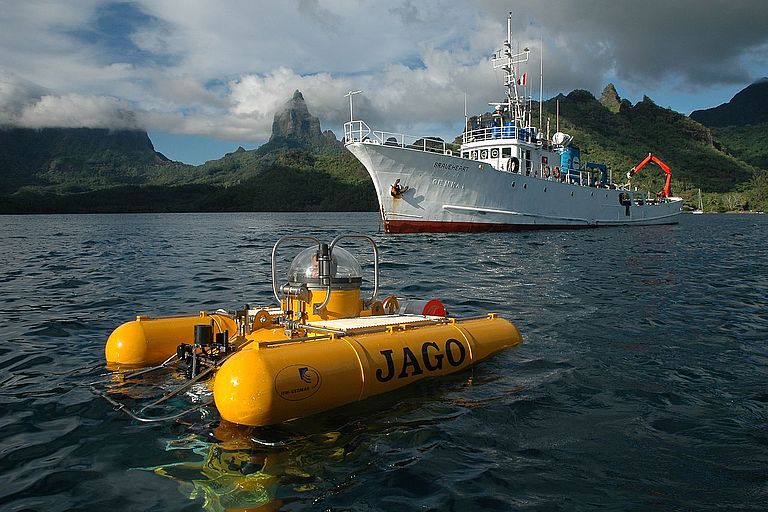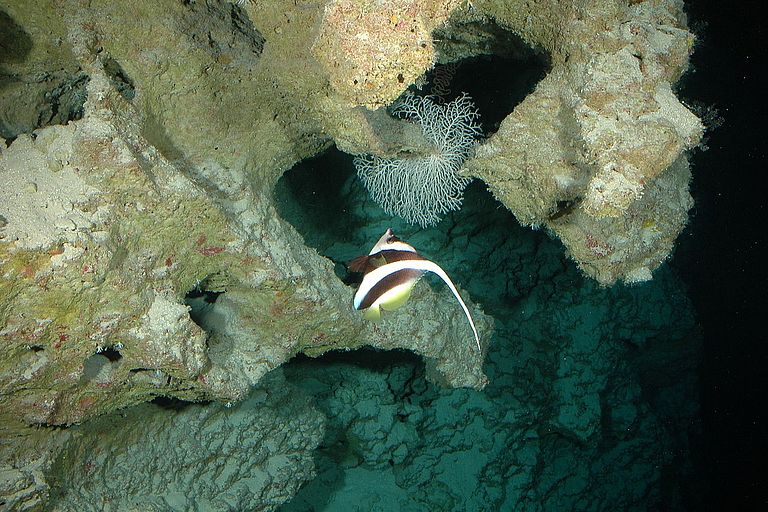The Sea Level’s Up and Down
21.07.2009/Kiel. Four weeks in the tropical South Pacific – many people associate this with a dream holiday: white beaches, blue waters and shorelines full of palm trees. However, for a team of marine scientists from the Leibniz Institute of Marine Sciences (IFM-GEOMAR) in Kiel, Germany, it was not like this but rather turned out to be a voyage into the past. They examined Tahiti and other islands of the French Polynesian archipelago using the manned submersible JAGO in order to further clarify the very complex sea level changes that have taken place over the past 20,000 years. – This was JAGO’s first mission in French-Polynesia.
The first glance is misleading. Despite the waves which may reach a considerable height, people standing on the shoreline watching the sea or travelling by boat usually get the impression that the ocean’s surface is a huge plain. – In fact the oceans show mountains and valleys up to about 200 metres high where ships have to travel across. This is caused by the inhomogeneous distribution of the mass density in the Earth´s mantle and its gravitational attraction. As soon as there is mass movement, like the waxing and waning of the large ice masses and the emergence of the formerly with ice covered continents sea level height will change. Hence the sea level is a complex interaction of the melting of continental ice and the redistribution of water masses which may change the sea level’s position although no water has been added or subtracted from the ocean.
In order to understand the complex sea level history since the last ice age in more detail, a group of scientists of the Kiel Leibniz Institute of Marine Sciences (IFM-GEOMAR), Germany, went on an expedition to the tropical South Pacific. “The surrounding region of Tahiti has a unique potential for our research area”, says Prof. Dr. Anton Eisenhauer, geochemist at the IFM-GEOMAR. “Here, we are far away from the once glaciated areas of the Northern Hemisphere that caused large sea level changes in the past”, says Eisenhauer. “We lack further disturbing influences because of two other reasons: the volcanic origin of the islands and the large distance to the continents”, adds paleo-oceanographer Prof. Dr. Wolf-Christian Dullo. The two scientists spent about four weeks in the surrounding area of Tahiti in order to examine fossil reef structures of the reefs of Tahiti and Moorea. For this kind of study the only German research submersible JAGO was an essential tool.
From onboard the chartered research vessel BRAVEHEART the submersible JAGO performed dives to water depths of 350 metres. A single dive along the steep and sometimes even vertical reef slopes of Tahiti and Moorea took up to seven hours. During these dives the researchers found karstified reef structures that reached down to water depths of 150 metres. “The karst formation indicates that these reefs once have been emerged above sea level and fallen dry. That means that they were located above the ocean’s surface”, explains Prof. Dullo. This presumably took place about 20,000 years ago during the coldest periods of the last ice age. “It was very impressive to sit inside JAGO, surrounded by crystal clear waters, having a view of almost 100 metres and seeing thousands of years of the Earth’s history passing by”, remembers Prof. Dullo. The data and samples which were collected with the submersible will be used to reconstruct the process of the sea level rise since the last ice age as detailed as possible.
During the second part of the expedition the scientist took samples of emerged and dry-fallen reefs on land. These reefs were formed when the sea level reached its peak about 6000 years ago. Since then, the sea level is slightly sinking in the entire Indo-Pacific area. The reason: the gravity of the continents. When the large continental ice sheets covering North America and Europe melted at the end of the last ice age, the northern continents lost an enormous mass which had pressed them into the Earth´s mantle. Since then, the slow emergence of the once glaciated areas provides an extra gravitational force pulling large amounts of seawater from the South to the North. In the Central Pacific this water is missing, as a result, the sea levels are sinking. From the age of the emerged fossil reefs and their height above the present sea level the scientists gain information about the timing of the post-glacial sea level change since 5000 years ago.
”We will use the samples to extend and complete our present picture of this process”, says Prof. Eisenhauer after he returned from the tropical South Pacific. The samples will be analysed with state-of-the-art analytic isotope techniques in order to identify the exact age of the fossil corals and other information which are hidden in the samples. Among others, the scientist are able to reconstruct the water temperatures that prevailed during the growth of the coral – with an accuracy of 0.5 degrees Celsius. “The isotope analysis allows us to nail down solid information about the chemical history of seawater and the sea level fluctuation”, says Prof. Eisenhauer. “When the patient is not willing to confess we will let the evidence speak”, he adds optimistically.
Contact:
Jan Steffen (Public Relations), +49 431 600-2811, jsteffen@geomar.de




